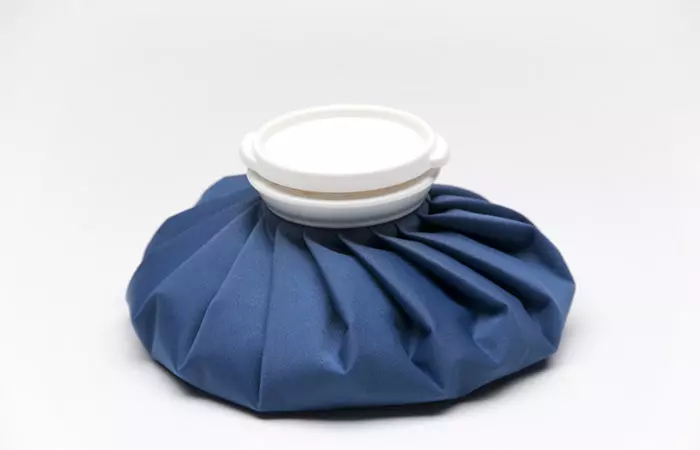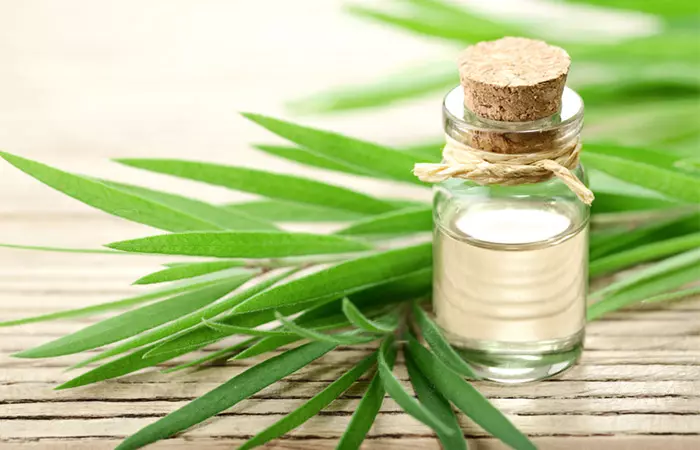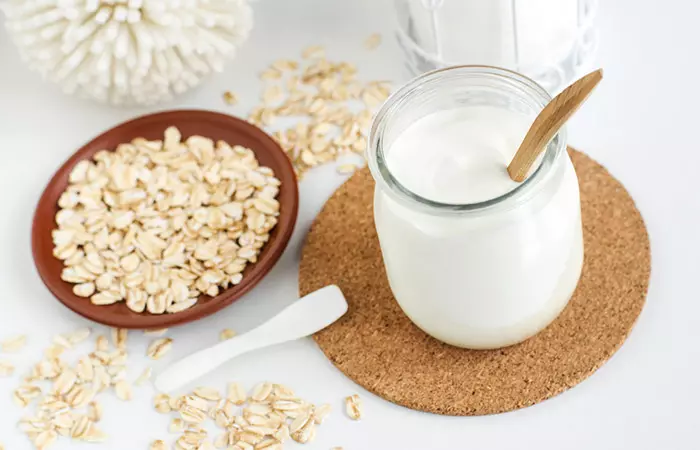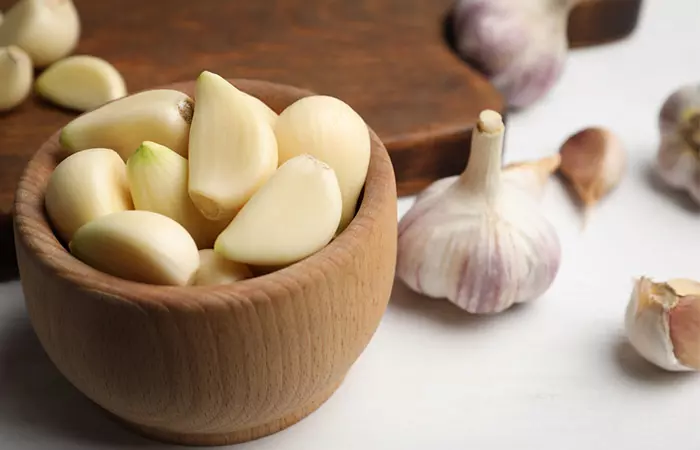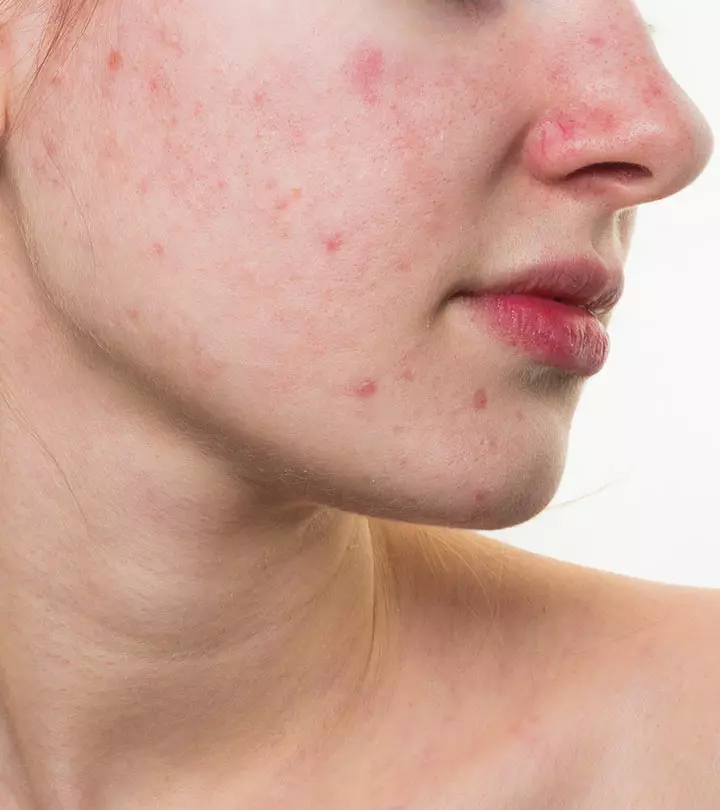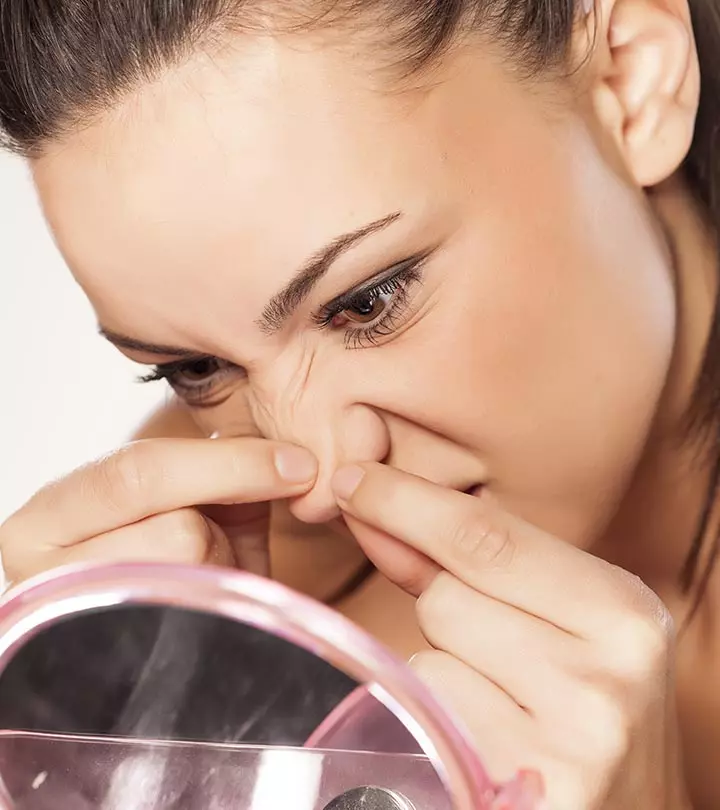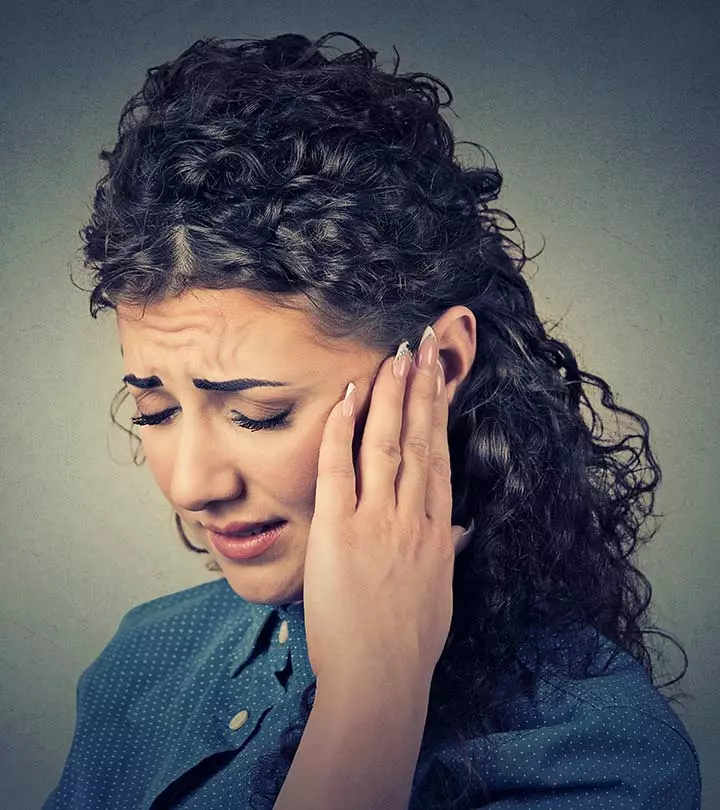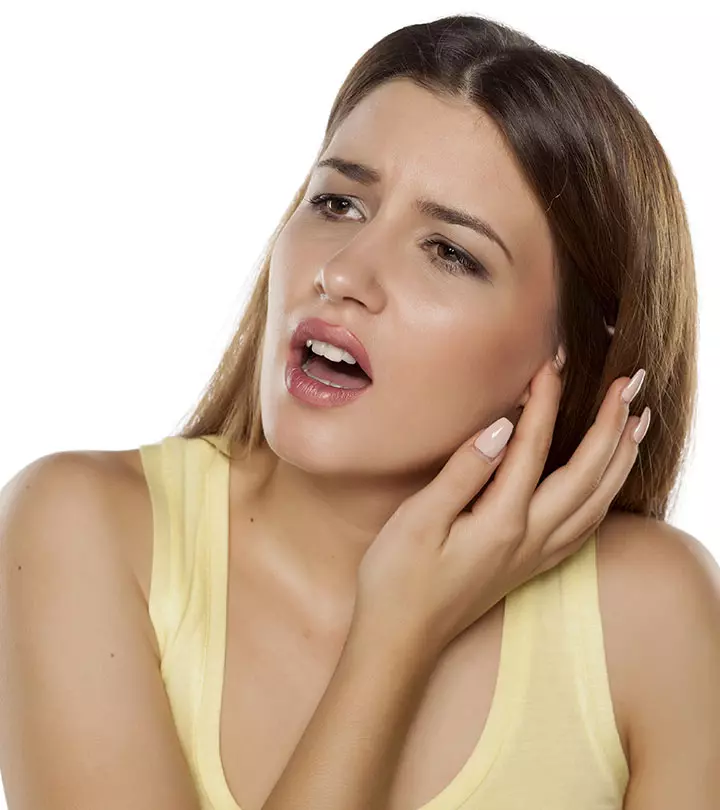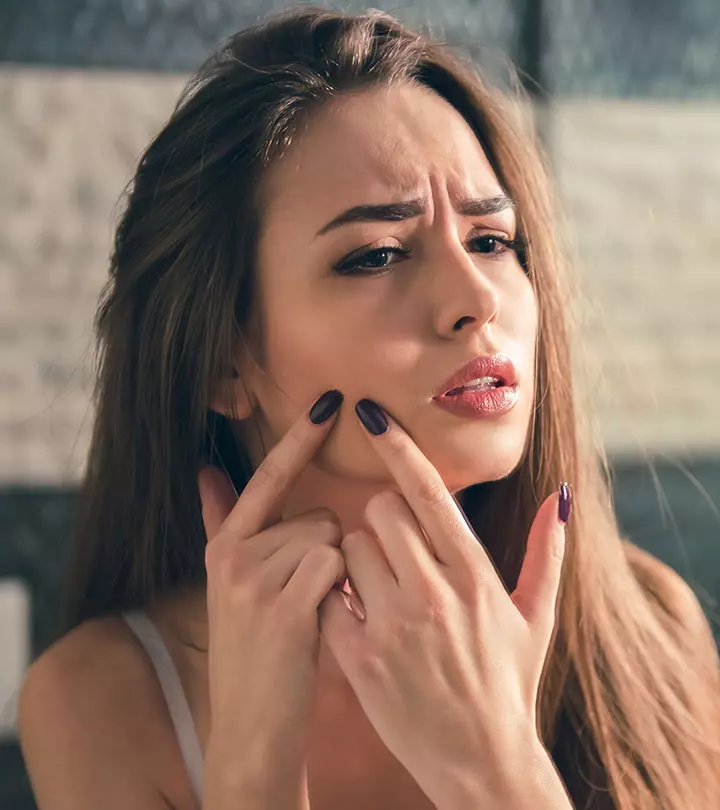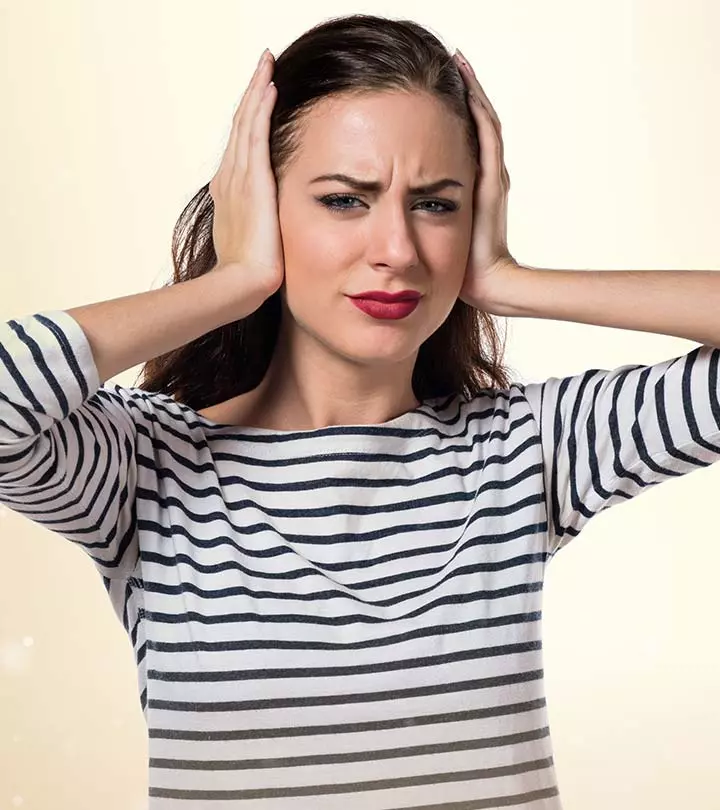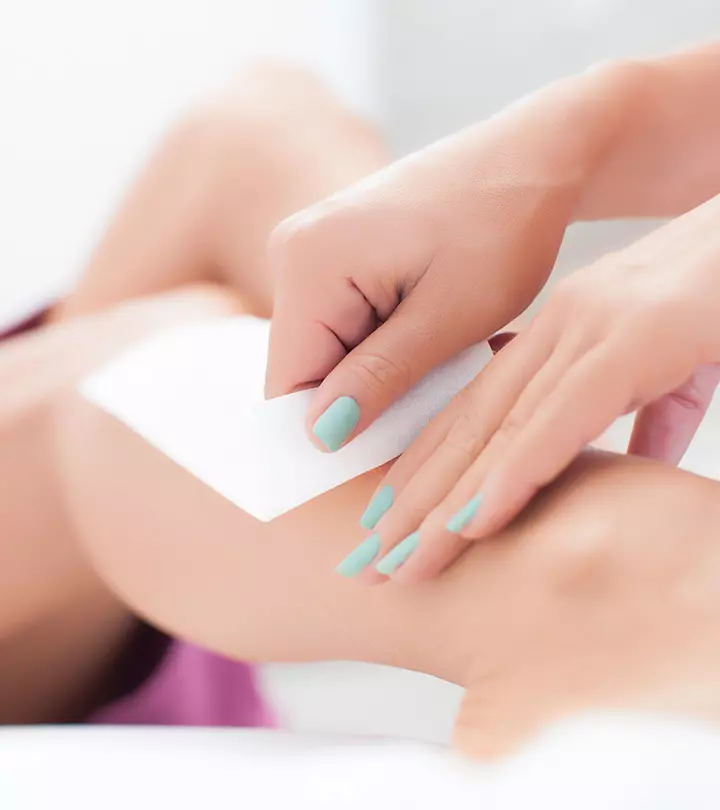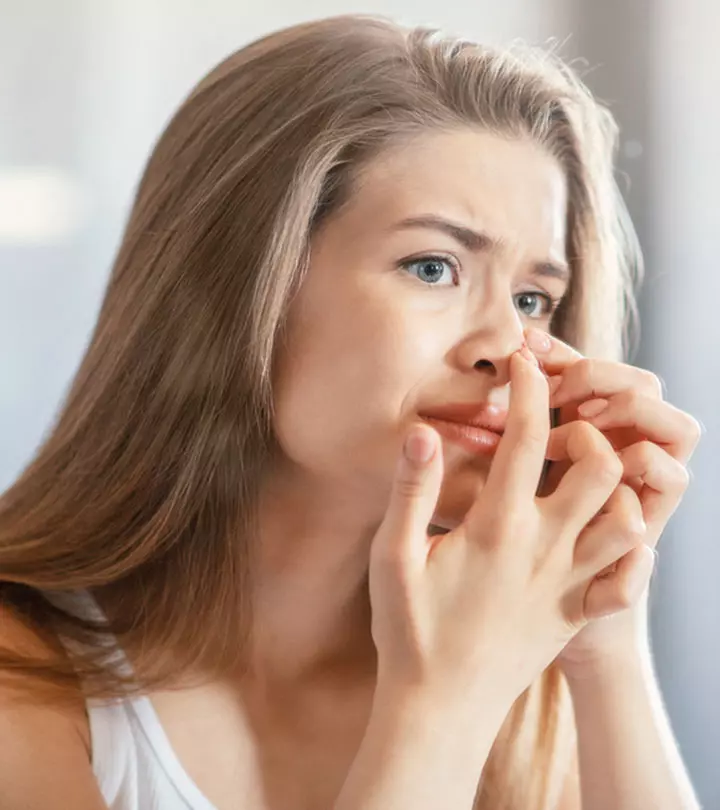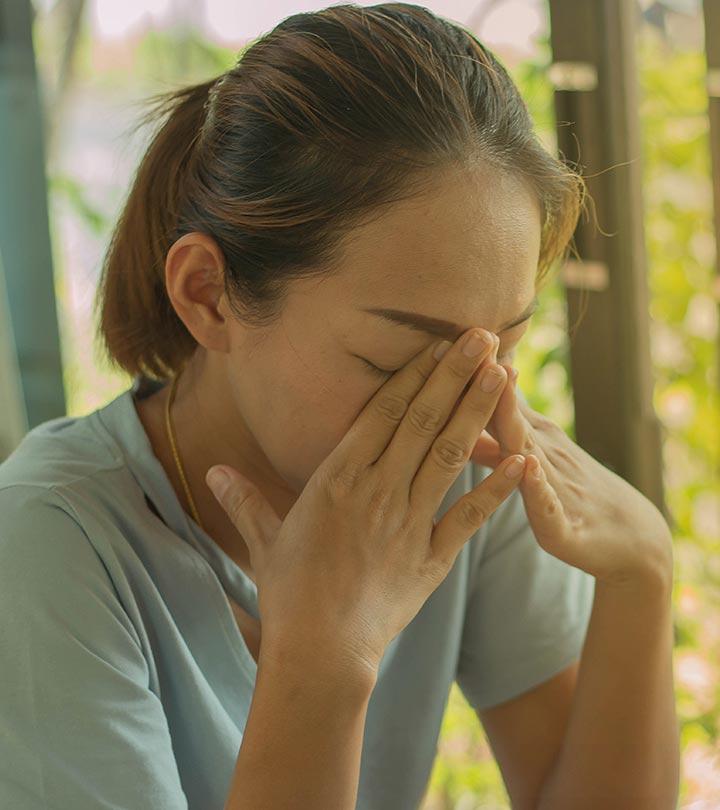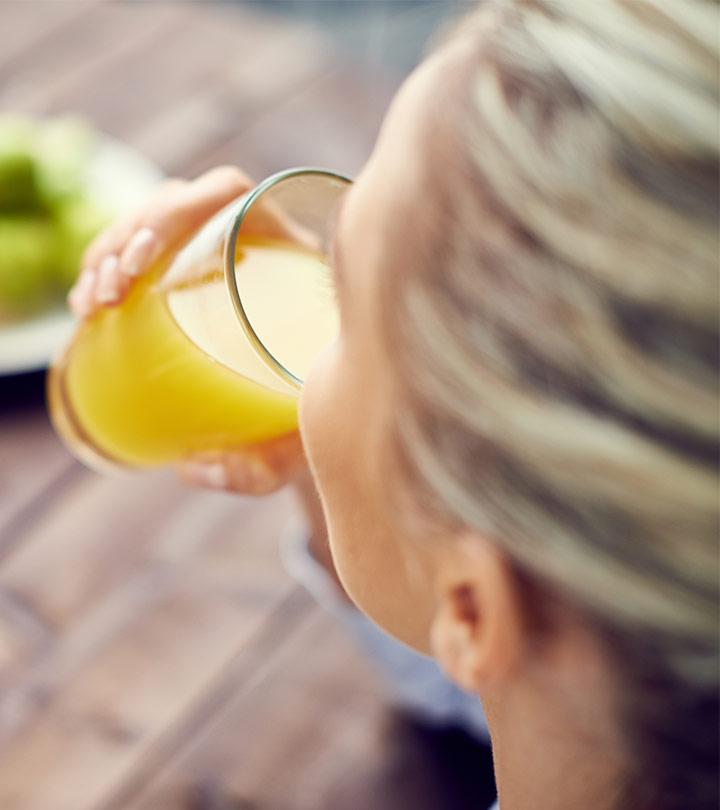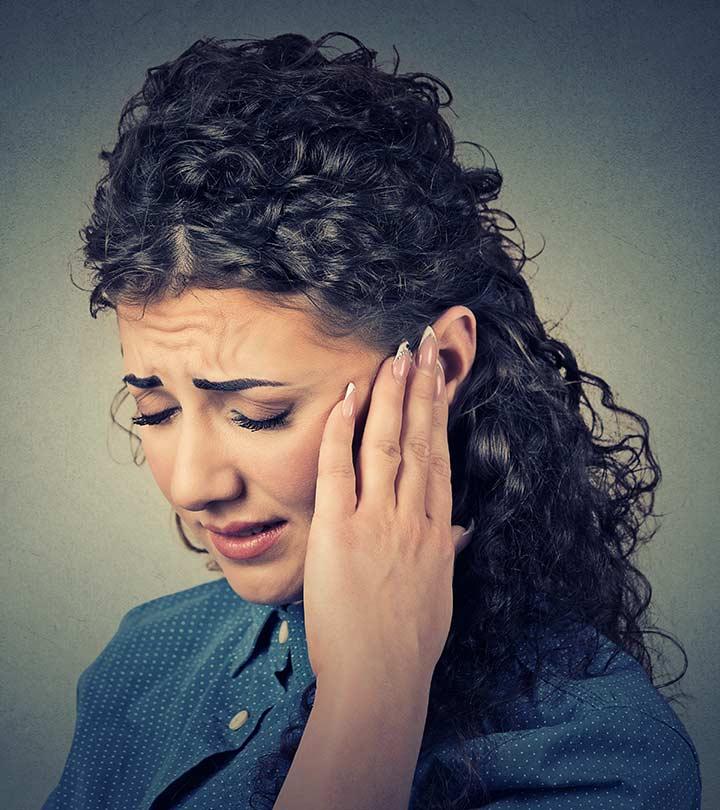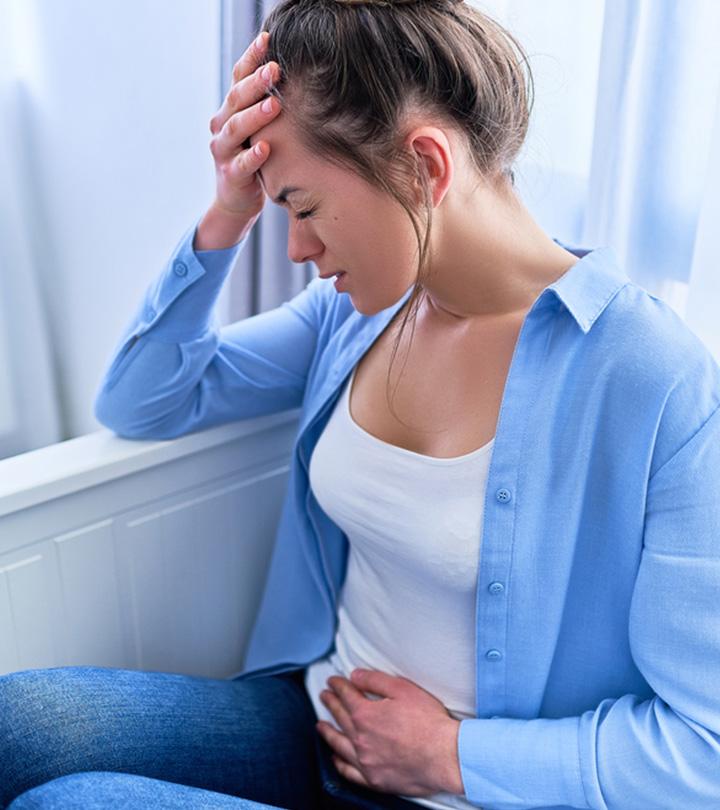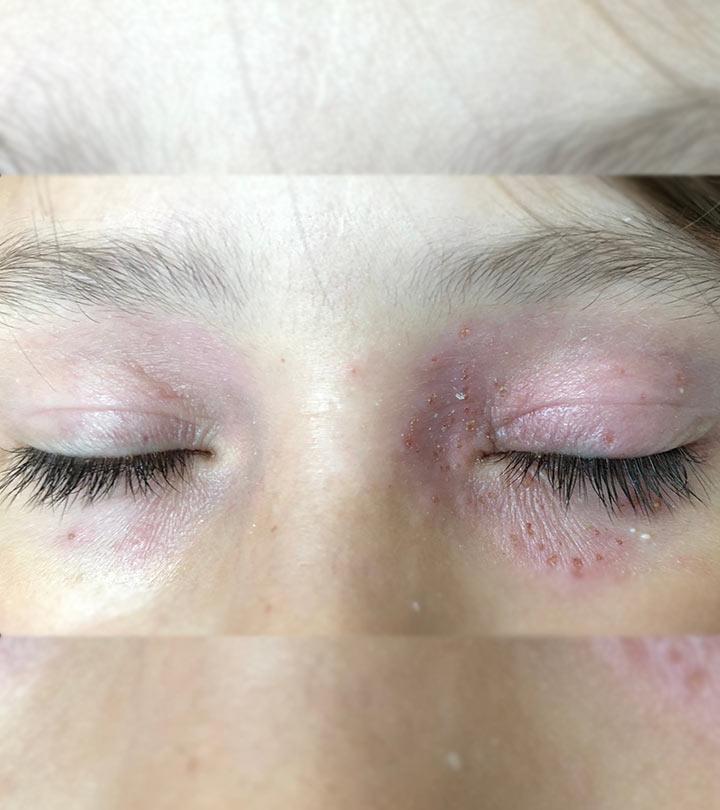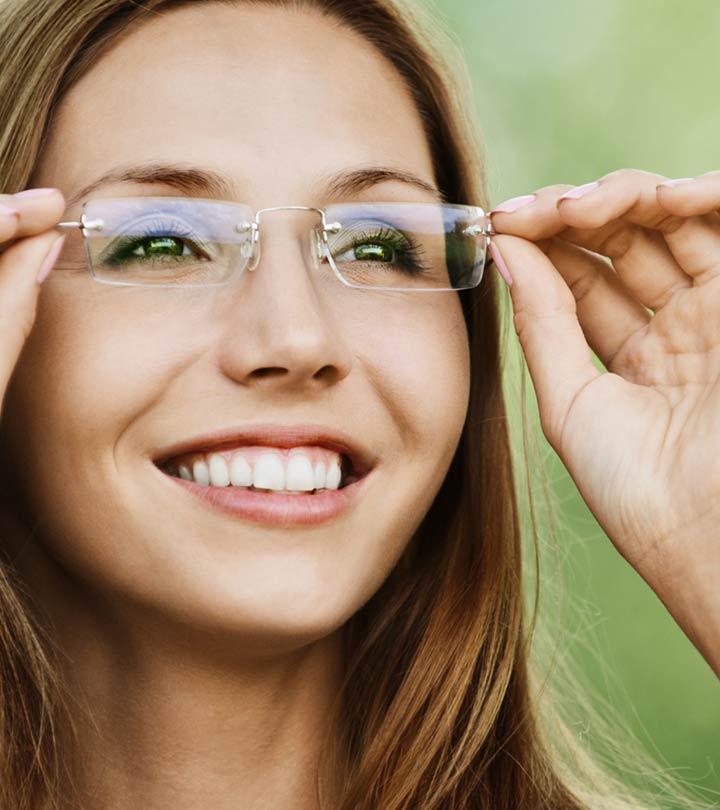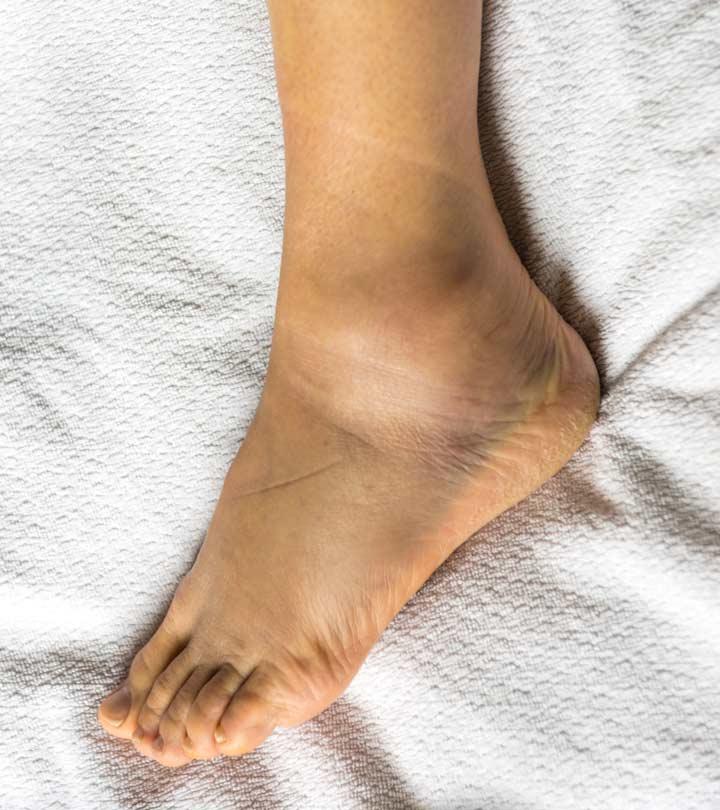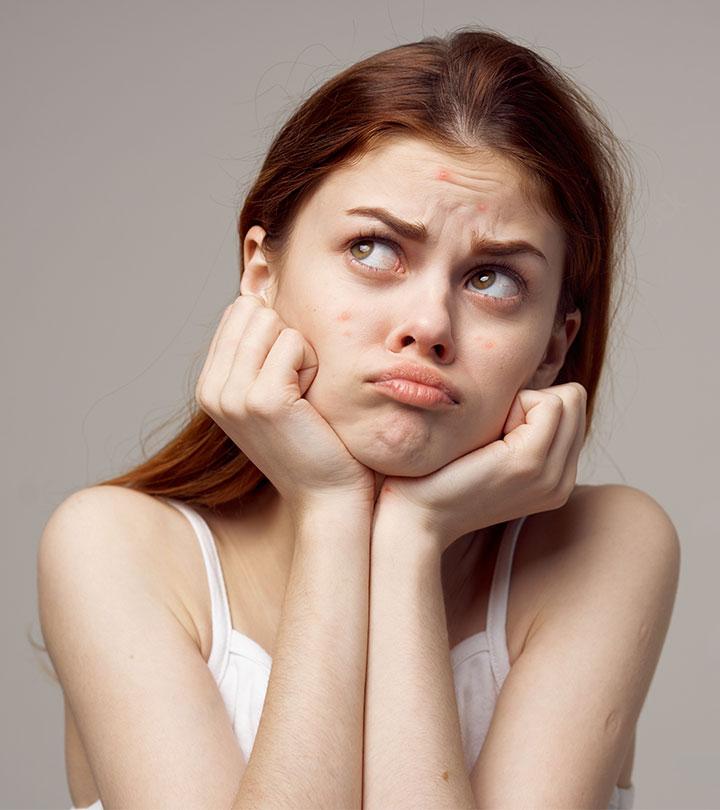Pimples Behind The Ears – Causes, 6 Home Remedies, And Prevention Tips
Don't let those pimples sit behind your ears and bother you; try out some effective remedies.
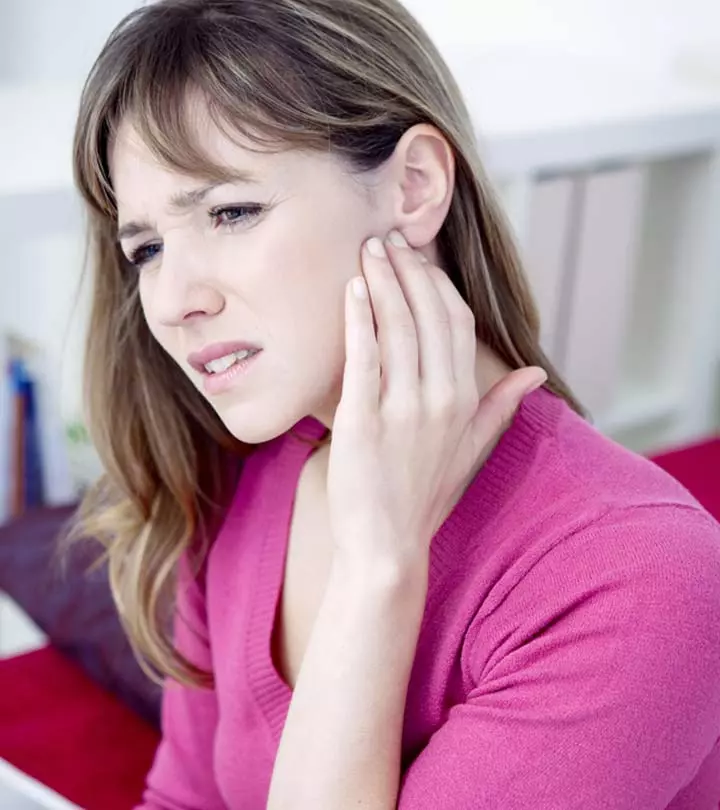
Image: Shutterstock
If you think those pesky pimples will not grow behind your ears, you are sorely mistaken. Those painful, itchy bumps you feel behind your ears are ear pimples. While pimples behind the ears heal on their own and are not harmful, they can cause pain and misery in their wake. So go through this article and check out the best home remedies that can help you treat them quickly and effectively. Scroll down to know more.
In This Article
What Causes Pimples Behind Ears?
Pimples or blackheads occur due to excessive oil production by the sebaceous glands when the skin pores get clogged by dead cells or exposure to stress.
Other factors that may contribute to this condition include:
- Poor hygiene habits
- Excessively dry or humid weather conditions
- Friction due to spectacles
- Ingrown hair
- Ear piercing infection
- Comedogenici Ingredients or substances in cosmetic products that clog the pores and increase the formation of pimples. cosmetics
- Diet (sugary foods, especially, which can aggravate acne)
According to the American Academy of Dermatology Association (AAD), about 50 million people in America are affected by acne every year. It is further estimated that about 85% of people in the age group of 12-24 years experience minor cases of acne. The survey also revealed a high percentage (15%) of adult women being affected by acne every year.
Dr. Emily Wood, MD, a board-certified dermatologist, says, “There are several causes of pimples or sores behind the earlobe. Sometimes, it can be due to occlusion of hair follicles or pores due to friction from headbands or hats rubbing the area. At other times, it can be related to a skin infection, including fungal or bacterial.”
She continues, “Yeast infections behind the ears are quite common. Research shows that some people are sensitive to a yeast that is part of most people’s normal skin flora, called Malassezia. Sensitivity to yeast shows up as redness and flaking, sometimes a severe form of dandruff.”
The occurrence of a pimple behind the ear could signify something grave as well. She adds, “Cysts sometimes form as part of the hair follicle, called epidermal inclusion cysts. These are cysts that can ooze a cheesy white material that is actually dead skin.”
Ear pimples are of various types and may appear on and around the ears. Know more about them in the next section.
Types Of Ear Pimples
- Whiteheads: These closed comedones occur when the skin pore or hair follicle gets clogged with dirt and sebum. They occur beneath the skin.
- Blackheads: These are open comedones caused by clogged pores and appear black due to air exposure.
- Cystic Pimples: These are deeper, filled with pus, and painful.
- Pustules: These are small pimples filled with pus and are red and tender to touch.
- Nodular Pimple: This is a severe form of acne/pimple. The bumps are painful, and firm, and feel like a tough lump under the skin of the ear.
- Nodulocystic Pimple: This is a painful, inflammatory, and deep pimple and may leave a scar.
All of these types of ear pimples can be quite painful, and you would want to treat them quickly. Though medical attention could be important in certain cases, the following home remedies may help supplement your treatment. Make sure you consult your doctor to understand which remedy may work to treat the pimple spots behind the ears.
Pimples behind your ears can be quite painful, and you would want to treat them quickly. Though medical attention could be important in certain cases, the following home remedies may help supplement your treatment. Make sure you consult your doctor to understand which remedy may work to treat the pimple spots behind the ears.
Home Remedies To Treat Pimples Behind Ears
1. Cold Compress
Studies show that repeated application of an ice pack/cold compress helps treat inflammation. It can achieve this by constantly drawing out heat from the skin (1). This can help reduce inflammation behind the ear.
You Will Need
A cold compress
What You Have To Do
- Apply the cold compress to your acne lesioni A damage or abnormal change in an organ or tissue of an organism caused by an injury or disease. and hold it there for at least 5 minutes.
- Remove and repeat three times in short, regular intervals.
How Often You Should Do This
Do this 3 times daily.
2. Tea Tree Oil
Tea tree oil possesses antimicrobial and anti-inflammatory properties (2). These properties may help fight the microbes that cause the zits.
You Will Need
- 5% tea tree oil
- Cotton swabs
What You Have To Do
- Dip a cotton swab in 5% tea tree oil.
- Apply it to your pimple and leave it on overnight.
How Often You Should Do This
Do this once daily.
3. Egg White And Honey
Anecdotal evidence suggests that egg whites reduce the size of skin pores and tighten the skin. This could help improve skin appearance. Honey has antibacterial properties (3). These properties may help fight the pimple-causing bacteria.
You Will Need
- 1 teaspoon of egg white
- ½ teaspoon of honey (optional)
What You Have To Do
- Blend a teaspoon of egg white.
- Add half a teaspoon of honey and blend again.
- Apply this mixture to the affected area and leave it on for 20 to 30 minutes.
- Wash off with water.
How Often You Should Do This
Do this 2-3 times daily.
4. Yogurt And Oatmeal
Oatmeal has antioxidant and anti-inflammatory properties (4). It was found to be useful in treating acne eruptions and dermatitis. Though more studies are needed to understand the efficacy of oatmeal in this regard, you may use it for pimple treatment.
Yogurt contains probiotics that may help reduce acne (5).
You Will Need
- 1 teaspoon of yogurt
- 1 teaspoon of oatmeal
- ½ teaspoon of honey (optional)
What You Have To Do
- Mix a teaspoon each of yogurt and oatmeal. You can also add a little honey to the mixture.
- Apply the paste directly to the pimple.
- Leave it on for 20 to 30 minutes.
How Often You Should Do This
Do this once daily.
5. Garlic
Garlic contains antimicrobial properties (6). These may help fight the pimple-causing bacteria and soothe the infected skin.
You Will Need
A minced garlic clove
What You Have To Do
- Apply minced garlic directly to the pimple behind the ear.
- Initially, leave it on for 20 minutes and then wash off. After a week or so, you may leave it on overnight.
- Those with sensitive skin may dilute the minced garlic with some water before application.
How Often You Should Do This
Do this once daily.
6. Citrus Juice
All citrus fruits are rich sources of vitamin C. Applying citrus juice to your pimple can help reduce inflammation and protect against the pimple-causing bacteria (7).
You Will Need
- A few drops of any citrus fruit juice (juice of orange, lemon, or lime)
- Cotton swab
What You Have To Do
- Soak a cotton swab in the citrus fruit juice.
- Gently press it to your pimple.
- Leave it on for 20 to 30 minutes before washing it off with lukewarm water.
How Often You Should Do This
Do this 1 to 2 times daily.
 Quick Tip
Quick TipThese remedies may help treat the pimples behind your ears. But if your condition persists, consult a doctor immediately. In the following section, we have discussed what you can do to prevent the recurrence of pimples behind the ears.
Prevention Tips
- Do not pop the pimple as this will aggravate the infection.
- Follow good hygiene.
- Scrub your skin once a week to prevent ingrown hair.
- Drink plenty of water.
- Quit smoking.
- Follow a well-balanced diet.
- Reduce your intake of sugar and processed foods.
 Quick Tip
Quick TipThese prevention tips can help promote overall skin health. The remedies discussed in the article may offer relief, but none of them are backed by concrete scientific research.
When To See A Doctor
If the pimples grow larger and become more painful, please visit your healthcare provider immediately. Test for any underlying condition and ask for the prescribed acne medication. Prompt action can help resolve the issue at the earliest.
Pimples behind the ears, most often, do not pose any serious threat. The right treatment can help ease the pain and symptoms in a matter of days. But should your symptoms persist or get worse, ensure you visit your nearest hospital. In some rare cases, these little lumps or spots behind the ears could be a sign of an underlying condition.
Infographic: Effective Home Remedies For Pimples Behind The Ears
Pimples behind the ears can heal on their own, but they cause pain. Those pus-filled bumps are really annoying. Thankfully, you can reduce the severity of the symptoms with some home remedies.
Check out the infographic below to learn which are the most effective home remedies to treat pimples behind the ears. Illustration: StyleCraze Design Team
Ear pimples, though benign, can cause a lot of pain, skin irritation, and discomfort if not treated quickly and efficiently. Clogged pores, humid conditions, ingrown hair, friction, and a diet high in sugary stuff are some of the causes of pimples behind ears. Use a cold compress, tea tree oil, egg white and honey mixture, minced garlic, citrus juice, or yogurt and oatmeal paste to get rid of ear pimples at home. In addition, avoid poking, squeezing, or pricking them to minimize the risk ear infection and further breakouts and follow an active lifestyle practice good ear hygiene, and consume a healthy, low-glycemici Foods that have a low effect on the blood sugar level in the body such as oats, carrots, and kidney beans. , and highly hydrating diet to prevent further ear pimples.
Frequently Asked Questions
Does shampoo cause acne?
If the shampoo you use is comedogenic, it may clog your skin pores. This can lead to acne vulgaris, which is a skin condition characterized by the formation of pustules, papules, and comedones over time.
How long does it take for pimples behind the ears to reduce?
In most cases, ear pimples heal in days, if not a week. If they persist for over 2 weeks, consult a doctor.
Is it normal to have pimples behind the ears?
Yes. Due to the presence of oil glands and hair follicles near our ears, the occurrence of whiteheads or pimples behind the ears is quite common.
Are there any nutritional supplements that can help to reduce the risk of pimples behind the ears?
Zinc supplements can help reduce mild to moderate acne breakouts and can be topically applied in the form of a serum (8).
Are there any foods that are especially beneficial for preventing pimples behind the ears?
Foods rich in zinc and alpha hydroxy acid can reduce and prevent flare-ups. Consume citrus fruits, leafy vegetables, poultry, lean meats, and oily fish to prevent further infection.
Are there any particular foods that should be avoided if you have pimples behind the ears?
Avoid consuming foods rich in carbohydrates, sugar, and omega-6 fatty acids. Reduce the consumption of fast foods, chocolates, dairy, and refined grains to maintain your metabolism and reduce the amount of insulin in your blood to prevent the skin from flaking (9).
Key Takeaways
- Pimples at the back of your neck can be caused by poor hygiene, ingrown hairs or even excessive sugar levels in your diet.
- Essential oils with antimicrobial properties like tea tree oil can reduce inflamed pimples and quickly treat them.
- Choose antioxidant or anti-inflammatory ingredients like oatmeal that fight triggered breakouts.
- Apply vitamin C containing ingredients like a lemon that can help reduce inflamed acne and minimize pimple-causing bacteria.
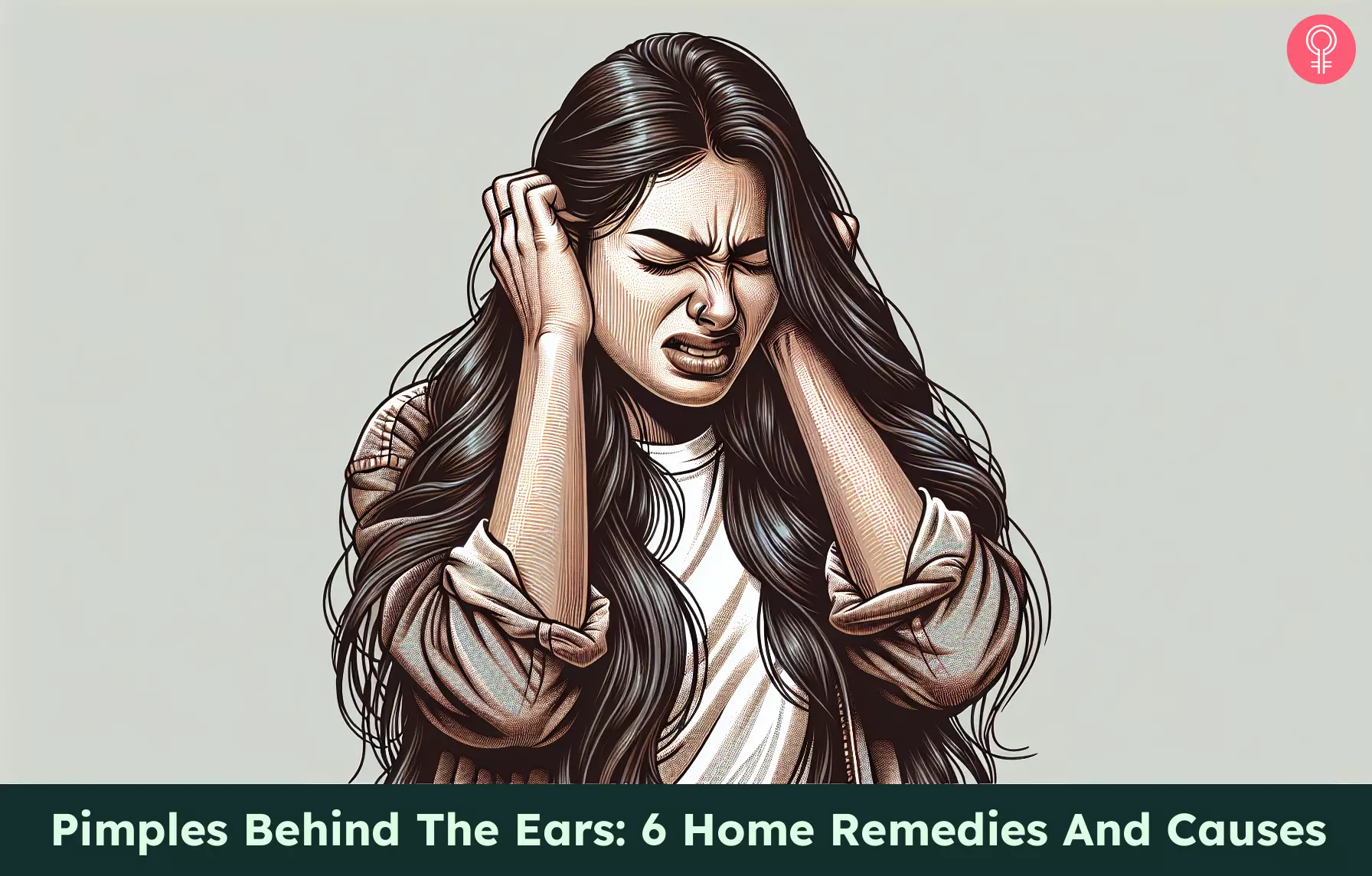
Image: Dall·E/StyleCraze Design Team
Learn some fast tips and tricks to treat painful pimples behind your ears with simple, easy-to-follow steps. Get rid of those pesky pimples hassle-free by checking out the video below.
References
Articles on StyleCraze are backed by verified information from peer-reviewed and academic research papers, reputed organizations, research institutions, and medical associations to ensure accuracy and relevance. Read our editorial policy to learn more.
- Acute effects of cold therapy on knee skin surface temperature: gel pack versus ice bag, BMJ Open Sport & Exercise Medicine, US National Library of Medicine, National Institutes of Health.
https://www.ncbi.nlm.nih.gov/pmc/articles/PMC5117055/ - Melaleuca alternifolia (Tea Tree) Oil: a Review of Antimicrobial and Other Medicinal Properties, Clinical Microbiology Reviews, US National Library of Medicine, National Institutes of Health.
https://www.ncbi.nlm.nih.gov/pmc/articles/PMC1360273/ - Honey: its medicinal property and antibacterial activity, Asian Pacific Journal of Tropical Biomedicine, US National Library of Medicine, National Institutes of Health.
https://www.ncbi.nlm.nih.gov/pmc/articles/PMC3609166/ - Oatmeal in dermatology: a brief review. Indian Journal of Dermatology, Venereology and Leprology, US National Library of Medicine, National Institutes of Health.
https://www.ncbi.nlm.nih.gov/pubmed/22421643 - The effect of probiotics on immune regulation, acne, and photoaging, International Journal of Women’s Dermatology, US National Library of Medicine, National Institutes of Health.
https://www.ncbi.nlm.nih.gov/pmc/articles/PMC5418745/ - Investigating Antibacterial Effects of Garlic (Allium sativum) Concentrate and Garlic-Derived Organosulfur Compounds on Campylobacter jejuni by Using Fourier Transform Infrared Spectroscopy, Raman Spectroscopy, and Electron Microscopy, Applied and Environmental Biology, US National Library of Medicine, National Institutes of Health.
https://www.ncbi.nlm.nih.gov/pmc/articles/PMC3147487/ - Role of Vitamin C in Skin Diseases, Frontiers in Physiology, US National Library of Medicine, National Institutes of Health.
https://www.ncbi.nlm.nih.gov/pmc/articles/PMC6040229/ - An Open-label Study Comparing Oral Zinc to Lymecycline in the Treatment of Acne Vulgaris The Journal of Clinical and Aesthetic Dermatology
https://www.ncbi.nlm.nih.gov/pmc/articles/PMC8211333/ - Association Between Adult Acne and Dietary Behaviors National Center for Biotechnology Information
https://www.ncbi.nlm.nih.gov/pmc/articles/PMC7287950/
Read full bio of Dr. Jyoti Gupta
- Dr. Emily Wood, MD, is a board-certified dermatologist and fellowship-trained cosmetic dermatologic surgeon specializing in cosmetic and medical dermatology. She has six years of experience in skin rejuvenation therapies, fillers, liposuction, sclerotherapy, and skin tightening. Dr. Wood graduated from Texas A&M University Health Science Center College of Medicine.
 Dr. Emily Wood, MD, is a board-certified dermatologist and fellowship-trained cosmetic dermatologic surgeon specializing in cosmetic and medical dermatology. She has six years of experience in skin rejuvenation therapies, fillers, liposuction, sclerotherapy, and skin tightening. Dr. Wood graduated from Texas A&M University Health Science Center College of Medicine.
Dr. Emily Wood, MD, is a board-certified dermatologist and fellowship-trained cosmetic dermatologic surgeon specializing in cosmetic and medical dermatology. She has six years of experience in skin rejuvenation therapies, fillers, liposuction, sclerotherapy, and skin tightening. Dr. Wood graduated from Texas A&M University Health Science Center College of Medicine.
Read full bio of Anjali Sayee
Read full bio of Monomita Chakraborty





